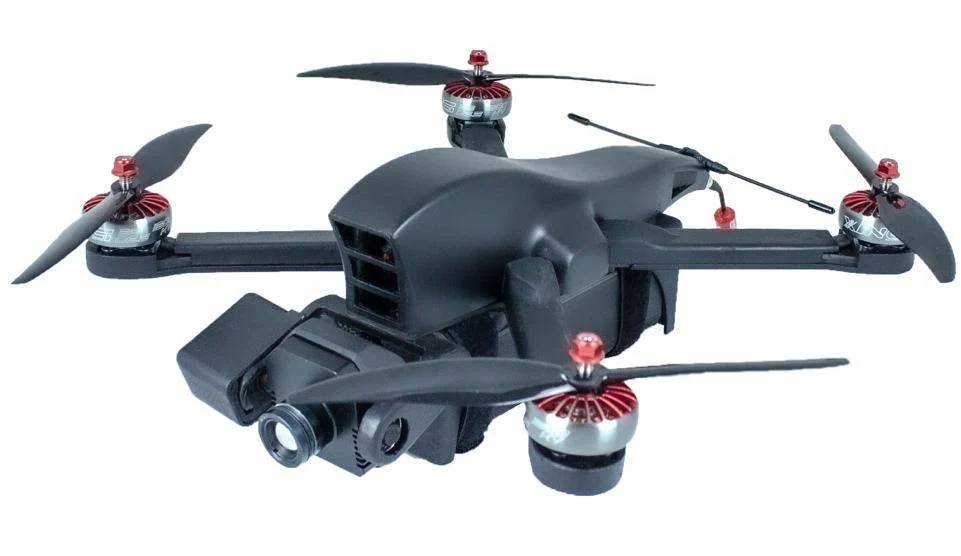The first BPLA400T quadcopter drone with a Russian-made heat imager has been engaged in Ukraine and will be upgraded to increase its range, CEO of the Astron Optical-Mechanical Design Bureau Vladimir Popov told TASS. BPLA400T was for the first time demonstrated at Army-2022 defense forum near Kubinka. It detects troops at a distance of 400 meters and hardware at 800 meters. The drone flies for 45 minutes at an altitude of 3 km. The range is over 5 km.
Follow Army Recognition on Google News at this link

The first Astron BPLA400T quadcopter drone with a Russian-made heat imager has been engaged in Ukraine and will be upgraded to increase its range (Picture source: Astron)
The UAV400T project was developed by the Astron optical-mechanical design bureau (Lytkarino). The main field of activity of this enterprise is thermal imaging and other optical systems. The UAV400T's appearance is associated with the war in Ukraine, Kirill Ryabov writes in en.topwar.ru: the first weeks of the operation showed the need for the creation and production of domestic thermal imagers suitable for use on reconnaissance UAVs.
The Astron bureau offered its developments in this area, and also created an air platform for carrying optics. So, during the recent Army-2022 forum in Kubinka, Astron for the first time showed a new drone and disclosed information about it. The first BPLA400Ts have already hit combat units involved in Ukraine. With the help of new drones, the Russian troops conduct reconnaissance, identify enemy targets and carry out target designation. In particular, this technique is used in the interests of artillery. “We increase both the quality and quantity of the craft. We work to improve characteristics, such as jam-resistance, smaller size, longer range, and others. Today, quantity is the main requirement,” CEO of the Astron Optical-Mechanical Design Bureau Vladimir Popov said.
The drone can carry a multi-channel optical-electronic station and transmit the picture to the operator in real time. “The unmanned vehicles are integrated into a single command system of the tactical level, which accelerates information provision to the headquarters and weapons. The drone can operate at night and in poor visibility”, CEO of the Astron Optical-Mechanical Design Bureau Vladimir Popov said, adding that the company receives good feedback from the Russian military in Ukraine. Astron has already produced hundreds of these drones.
The UAV has a fairly simple design and does not fundamentally differ from other modern products of this kind, Kirill Ryabov comments. There is a plastic fuselage on which the bases of four propeller groups are hinged. For transportation, the latter are folded along the body. The battery and optical system are suspended under the fuselage. The length of such a device, excluding screws, does not exceed 400 mm, and the width is less than 350 mm. Height including all devices - 114 mm. The take-off weight is only 1195 g.

Astron BPLA400T dimensions (Drawing source: Astron)
Four electric motors with two-bladed propellers and an electronic control system allow horizontal speeds up to 10 m/s and vertical (on the rise) up to 3 m/s. The flight altitude reaches 3 km. The device is capable of flying for 40 minutes. (calm) or hang for up to 50 min. The range is up to 6 km. It can be used in a wide range of air temperatures and with winds up to 7 m/s.
The UAV400T is equipped with a remote control system and also has satellite navigation facilities. In-flight control is carried out by radio from the operator's console. There are probably standalone modes of operation. Declared the use of secure radio communication channels. The enemy does not have the ability to take control or determine the starting point.
The key element of the system is a thermal imaging camera on a gyro-stabilized suspension. The camera has an uncooled matrix with a resolution of 384x288 and a field of view of 40° x 30°. Frame rate - 30 fps. Such a camera allows you to monitor day and night, as well as recognize various objects. A car-type target is recognized at distances up to 800 m. A person can be distinguished from 350 m during the day or from 400 m at night.
There are no other optical means. A television channel and a laser rangefinder-target designator are not provided. This limited the ability to observe but allowed for the reduction of the mass of the payload.
Defense News March 2023















